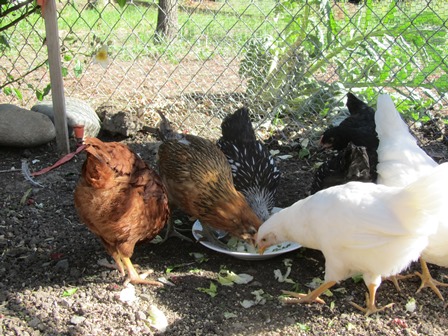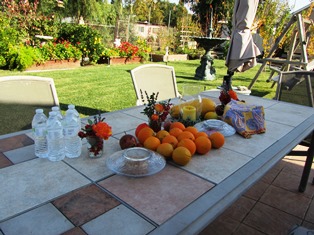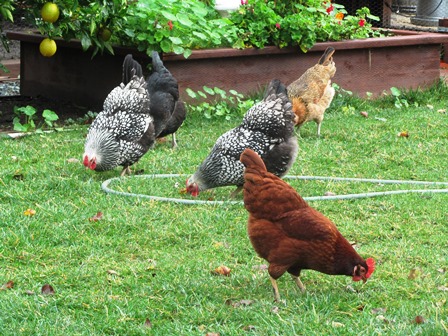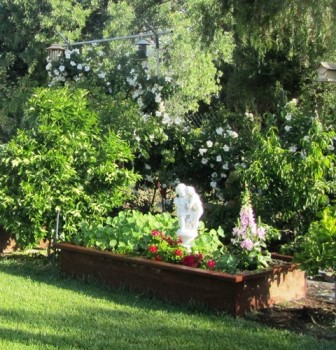Consider This Before You Get Backyard Chickens
My bedroom window faces the back of our property where the chicken coop sits. Every morning, I’m awakened by repeated grauwkkkk sounds made by the Silver Laced Wyandottes and the Rhode Island Red hens, the noisiest ones of all my chickens.
I wish I’d read up more on the breeds before making my selections at the feed store. I love keeping chickens and the eggs are fabulous. That said, there are some of the areas I wish I’d known more about. I might have chosen different breeds.
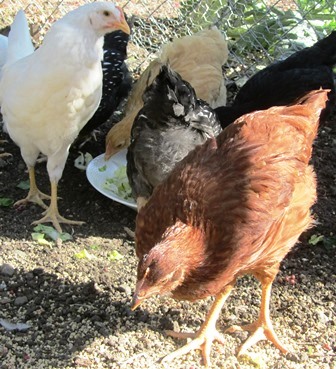
Rhode Island Red hen seems to be at the top of the pecking order in this small flock of backyard chickens
1. Noisemakers–some breeds are noisier than others. I seldom hear the occasional cluck from my White Leghorns, but the Wyandottes never seem to shut up. Get a bunch of hens together and conversing, and you’ll soon see what I mean.
2. Snacking–chickens love snacks but give them judiciously. If they consume too many treats like blueberries, fresh corn from the cob, and bits of bread or rice, the quality of their eggs may suffer. But as soon as you give them treats, they become your best friends and will follow you around.
3. Pecking–chickens quickly establish a pecking order; they will also peck you . . . some harder and more aggressively than others. My Black Sex Link hen just seems kind of mean and pecks with impatience. But the Rhode Island Red will give an almost loving peck that’s not hard and doesn’t hurt.
4. Broodiness–when a hen goes broody (like my Wyandotte and Buff Orpington hens), her hormones have told her she needs to sit on a clutch of eggs until they hatch (about three weeks). But if you do not have a rooster to have fertilized those eggs, the hen will sit on them anyway, tying up a nesting box and hoarding eggs that will have to be tossed out when she finally figures out that she’s engaged in a futile pursuit of baby chicks. Some breeds tend to broodiness more than others.
5. Water and Food–chickens need water, love crumble, and can benefit from a serving of cracked grains and dried worms. To ensure their egg shells are sufficiently rigid, they may also need additional oyster shell calcium. And like all living beings they need fresh water. If they go without water, they can stop laying for weeks. I’ve figured out the cracked grains must be so tasty they are like cotton candy and after them, the hens don’t want their good food.
6. Diminishing Returns–hens begin laying when they are about five months old. After the first year, egg production will fall off about 20 percent in subsequent years. They generally lay eggs for seven or eight years, but can live to be older and produce no eggs.
7. Egg size–when a hen tries to lay too large of an egg, it can cause a condition called cloaca prolapse. It can claim her life–I’ve lost two chickens to this problem. One was an Ameraucana heritage chicken that laid blue-green eggs. I do miss her as she was skittish but quiet.
8. Moving Hens or a Rooster–if you are getting the gift of a chicken from a neighbor or friend, move that chicken into the flock at night. When he or she wakes up in the morning, the whole event will be a fait accompli and will generate less stress for all involved.
Farmette Chores, the Writing Discipline, and Landscapes
Each day on my farmette starts with chores involving plants and animals . . . and writing. The latter might seem a bit strange until you understand that my farmette–with its organic heirloom vegetables, eggs, and honey–has evolved into a brand that includes my forthcoming Henny Penny Farmette novels. It’s business. I have to write three novels in three years. I’ve already written two.
Like any business that involves regular tasks for keeping the enterprise thriving, my farmette novels require a daily commitment to writing. Excellence in my writing endeavors is just as important to me as the quality of my Henny Penny Farmette jams, honey, eggs, and this blog.
I rise early, at 4:00 AM, to get a jump on my day. The roosters start crowing around that hour, but the sleepy hens remain on the roost until daylight. I like to stroll outside, see the edges of the black sky turning lighter at the eastern horizon, observe the position of the moon and stars, feel the cool predawn air on my face, and notice the silent vapor of fog receding like gray shroud being tugged upon.
I enjoy the scent of pine and orange blossoms (when the trees are in bloom), and take note of the occasional spritzing of a skunk or cat marking its territory while out prowling. These observations become notes in my journal.
At bedtime and when I awaken during the night, I practice yoga nidra, a state of deep relaxation and lucid dreaming. Often, though, the lucidity may be nudged aside as sleep and dreams in which I am not aware of my physical environment take over. Still, I sometimes work through problems in my life or my stories and awaken with a solution . . . sometimes, but not always.
During the morning hours before sunrise, following a good night’s sleep, I feel sharpest and most in tune with nature and my deepest, inner Self. One of my favorite writers John O’Donohue observed the profound and numinous presence of nature and wrote in his book Anam Cara: “Landscape is not all external, some has crept inside the soul. Human presence is infused with landscape.”
The Henny Penny Farmette landscape has echoes from the past in it. I’ve re-created my grandmother’s farm garden where I spent happy hours of my childhood. But also, I’ve got my own personal stamp on this landscape. It’s a lot of work, but I embrace the daily chores and the discipline needed to keep the farmette and a book series going. It’s an ongoing journey to a new horizon.
 Facebook
Facebook Goodreads
Goodreads LinkedIn
LinkedIn Meera Lester
Meera Lester Twitter
Twitter





